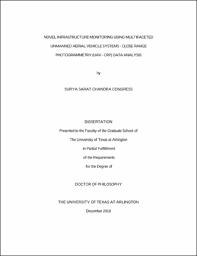| dc.description.abstract | Remote sensing is a method of collecting data without making any physical contact with the object under inspection. Modern day remote sensing kicked off with the invention of the camera and continued on to the invention of advanced satellite mounted sensors. Photogrammetry is defined as a science that measures distances using one or more images captured remotely. Remote collection of images within a range of 1000 ft is termed close-range photogrammetry (CRP).
Unmanned aerial vehicle systems (UAV or UAS) have become a popular means of remotely gathering information and assessing infrastructure conditions due to their versatile nature. Multirotor and fixed-wing are two types of UAVs that are frequently used in field operations. Close-range photogrammetry (CRP) using UAVs can generate dense point cloud images, orthomosaics, digital elevation models (DEMs), and digital terrain models (DTMs) in a short time period.
Analyses of these models help transportation engineers and agencies to understand the infrastructure health conditions. Several studies have addressed UAV-CRP surveys for infrastructure health condition assessments primarily due to restrictions imposed by the Federal Aviation Administration (FAA) on UAV studies and their operations in the field. After the introduction of Part 107 exemption of UAV operations by FAA in August 2016, more studies have been planned and performed with UAVs, evaluating their abilities to perform infrastructure condition assessments.
In the present research, the UAV-CRP technology using a hexacopter was primarily used to conduct infrastructure monitoring and assessments. As a part of the research, a comprehensive literature review of remote sensing and photogrammetry studies, UAV-related research by different states’ departments of transportation, calibration checks for different accessories, as well as research on pavement and bridge infrastructure management was conducted. Then, a comprehensive calibration study was performed by conducting total system error analysis on both the UAV as well as accessories used in the research. This unique calibration analysis provided a much-needed understanding of how environmental conditions, including field temperature conditions, lens temperatures, flight altitudes, humidity, and different overlap conditions influence the quality of images captured as well as three-dimensional dense point cloud models generated using these images.
Later, UAV-CRP technology was used in various infrastructure inspection studies owing to its multifaceted benefits. UAV-CRP studies on pavement sections showed they could provide pavement distress data including information on longitudinal and transverse cracks, permanent deformation or rutting, as well as pavement characteristics such as longitudinal and cross-slope values, and sight distances at crossings. All the photogrammetry-based imaging analyses yielded results that are in agreement with other traditional methods. UAV-CRP studies performed on various construction material stockpiles yielded volume results matching with ground truth measurements from traditional field survey results.
Bridge sites were inspected using UAVs equipped with both top and bottom gimbals to provide a complete 360° view of the bridge including substructure and superstructure elements. UAV-CRP results can provide condition assessments on approach slab settlements, movements and cracking in abutment and wing walls, bridge foundation conditions, columns, and under-bridge decks as well as upper deck. UAV-CRP studies conducted on rail corridors also proved that the photogrammetry results could be used to evaluate encroachments at crossings, and washout site detection including an appraisal of factors that may have contributed to washouts. UAVs were also used for emergency operations immediately after a hurricane event and proved its value in providing debris assessments in post disaster reconnaissance studies performed in Beaumont, Texas.
A preliminary cost analysis indicates that UAV-CRP technology could provide an inexpensive way of monitoring infrastructure conditions and gathering valuable data related to infrastructure-related annual and biennial rating surveys. All the procedures, analyses, and results indicate the UAV-CRP tool provides a quick, efficient, and safe method for assessing infrastructure health conditions. | |


